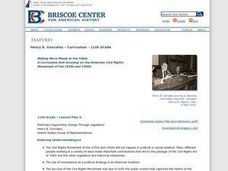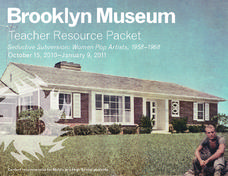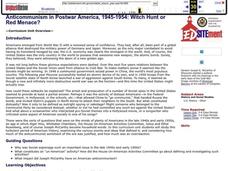Curated OER
American Women Who Shaped the Civil Rights Movement Explored Through the Literature of Eloise Greenfield
Examine the women who contributed to the Civil Rights movement. In groups, children read excerpts of writings from Eloise Greenfield and research the women she mentions using the internet. To end the lesson, they create a timeline of...
Curated OER
Cold War Era Film Censorship: High Noon- a Slice of Americana Or Communist
Students study of the effects of the Cold War on the home front. They analyze the film High Noon according to an abbreviated version of the standards that films were judged by in the early 1950s and determine whether or not High Noon is...
Curated OER
Jazz Music and the Crisis Over School Desegregation
High schoolers will learn to appreciate the civil rights movement with a focus on Little Rock, Arkansas. They will also acknowledge Louis Armstrong's unparalleled contributions to American music.
Curated OER
Making More Places at the Table: The American Civil Rights Movement of the 50's and 60's
Eleventh graders examine the biography of Henry B. Gonzalez. They examine primary source documents from Congressman Gonzalez's personal papers related to his contributions to the Civil Rights Movement.
Albert Shanker Institute
The March on Washington Logistics Then and Now
I have a dream ... that all pupils will be able to organize a march of their own after learning about how Bayard Rustin organized the 1963 March on Washington for civil rights. Young reformers work collaboratively examining informational...
Bill of Rights Institute
Post-WWII Boom: Transition to a Consumer Economy
The war is over! Scholars investigate an AP review video to uncover the post-WWII era in the United States. Viewers examine and analyze the consumerism that arose in post-war America. This is the eighth installment of a nine-part series.
Brooklyn Museum
Lorna Simpson: Gathered
Lorna Simpson is a photographer who has put together a collection of photos from the 1950s in order to challenge the idea that primary source documents are objective in their portrayal of history. Learners are introduced to Ms. Simpson's...
Curated OER
Sondheim: Voice of Cultural Change
Students explore Stephen Sondheim's contributions to musical theatre in the context of the dramatic cultural shift that occurred in American life in the late 1950s, 1960s, and 1970s.
Curated OER
Understanding JFK's Presidency through his Speeches
Students reflect and discuss the major events that happened in the United States in the 1950's and 1960's. In this U.S. History lesson, students read and analyze the famous speeches during this time frame, then complete a worksheet that...
Brooklyn Museum
Seductive Subversion: Women Pop Artists, 1958–1968
What role did women play in pop art during the 1950s and 1960s? The class researches the role of women in mid-century America and how those roles were portrayed through the pop art of the time. They use an excellent set of guiding...
Curated OER
Witch Hunt or Red Menace? Anticommunism in Postwar America, 1945-1954
Young scholars investigate what constitutes an "un-American" activity and why Soviet espionage was such an important issue in the 1940's and 1950's. Joseph McCarthy's impact on American anticommunism is examined in this lesson. There are...
Social Studies School Service
“Duck and Cover” (Civil Defense)
Bert the Turtle models for viewers the 1950s Civil Defense Duck and Cover strategy that was supposed to protect citizens from a nuclear blast. After viewing the video, watchers are asked to consider the motivations of the producers of...
State Bar of Texas
Brown v. Board of Education
You walk each day over 20 blocks to school as a 9-year old because the color of your skin does not allow you to attend a school in your own neighborhood. Scholars use the 1954 Supreme Court case Brown v. Board of Education to investigate...
Curated OER
Jazz in America Lesson Plan 6
Young scholars survey bebop, cool jazz, and hard bop. They explore how bebop, cool jazz, and hard bop reflected American culture and society in the 1940s and 1950s.
Curated OER
"Police Action": The Korean War, 1950-1953
Students investigate facts about the war in Korea in the 1950's and attempt to classify American foreign policy as a triumph or a failure. Why the U.S. became involved and the unpopularity of the war in America forms the focus of this...
Digital Forsyth
Civil Rights and Active Citizenship
As part of a study of the American Civil Rights movement, class members search the Internet to find important facts, people, events, and pictures that they use to create a timeline of events between 1955 and 1970.
Curated OER
Prudence Crandall House and Little Rock High School
Pupils examine how Prudence Crandall influenced the education of African Americans in New England prior to the Civil War and compare and contrast events in Canterbury, CN in the 1830's to those in Little Rock, AR in the 1950's.
Curated OER
Civil Rights Leaders
Tenth graders investigate three American leaders from the Civil Rights Movement while they examine the early 1960's and the topic of racial equality. They listen to music from the era, read speeches, and look at images of Martin Luther...
Curated OER
Ceremony
Students complete multiple lessons to identify the human rights and social justice for Native Americans. In this human rights lesson, students complete fifty one days of activities to a lesson titled "Ceremony" about the Native...
Curated OER
Cold War into Guerilla War
Students examine the Cold War and the War on Terror. In this American history lesson, students research print and nonprint resources regarding both wars. Student compare the experiences of youth at the time so both the Cold War and War...
Curated OER
Consumer Culture in the 1950s: New Shopping Centers and Advertising trends
Students examine the effect of suburbs on American cities. They identify the changes the cities had to face after people moved elsewhere. Using primary source ads, they compare them with contemporary ads and discuss what can be found out...
Curated OER
The Automobile’s Influence on Post-WWII Suburbia
Eighth graders explore post World War II America. In this American History lesson, 8th graders analyze primary and secondary sources to research how the automobile influenced the growth of suburbs, and how the growth of suburbs...
Carolina K-12
Joe McCarthy and the Red Scare
In the 1950s, how did the Red Scare and the actions of Senator Joseph McCarthy affect the American people? Your young historians will analyze primary source documents on the Red Scare, participate in a "find the Communist" simulation,...
Stanford University
Public Housing
The Fair Deal was meant to give Americans after World War II a basic standard of living. Those in public housing often found that promise fell short. Learners consider whether the effort was successful by evaluating images, testimonies,...
Other popular searches
- American Lifestyle 1950s
- The American Dream 1950's
- 1950s American Economics
- 1950s American Bandstand

























